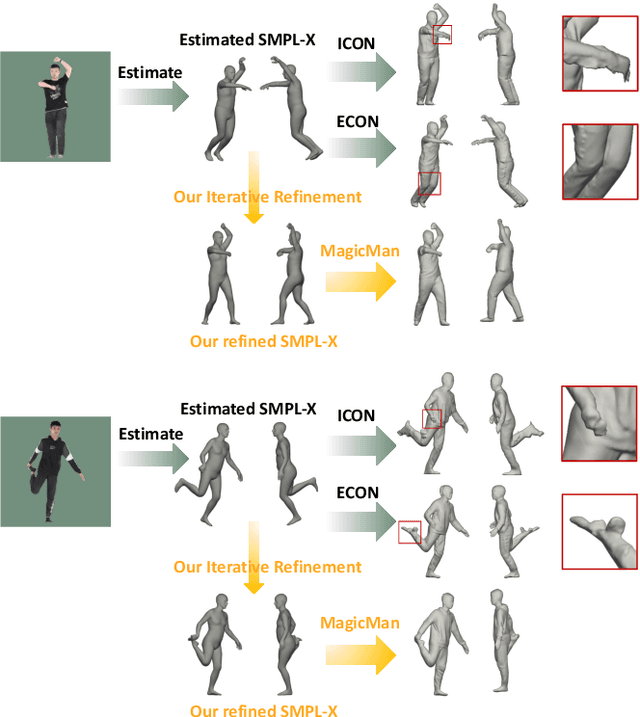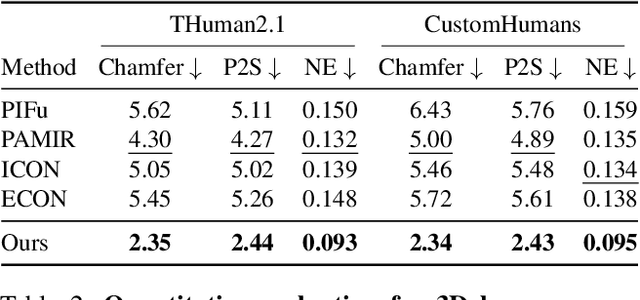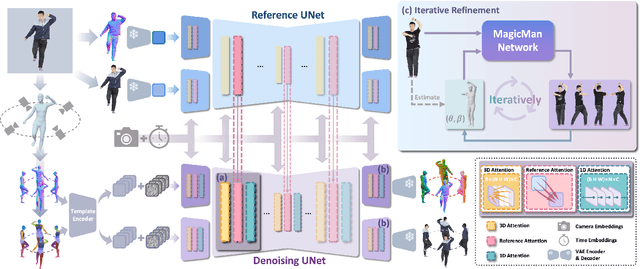Liyang Chen
Detecting and Mitigating Insertion Hallucination in Video-to-Audio Generation
Oct 09, 2025Abstract:Video-to-Audio generation has made remarkable strides in automatically synthesizing sound for video. However, existing evaluation metrics, which focus on semantic and temporal alignment, overlook a critical failure mode: models often generate acoustic events, particularly speech and music, that have no corresponding visual source. We term this phenomenon Insertion Hallucination and identify it as a systemic risk driven by dataset biases, such as the prevalence of off-screen sounds, that remains completely undetected by current metrics. To address this challenge, we first develop a systematic evaluation framework that employs a majority-voting ensemble of multiple audio event detectors. We also introduce two novel metrics to quantify the prevalence and severity of this issue: IH@vid (the fraction of videos with hallucinations) and IH@dur (the fraction of hallucinated duration). Building on this, we propose Posterior Feature Correction, a novel training-free inference-time method that mitigates IH. PFC operates in a two-pass process: it first generates an initial audio output to detect hallucinated segments, and then regenerates the audio after masking the corresponding video features at those timestamps. Experiments on several mainstream V2A benchmarks first reveal that state-of-the-art models suffer from severe IH. In contrast, our PFC method reduces both the prevalence and duration of hallucinations by over 50\% on average, without degrading, and in some cases even improving, conventional metrics for audio quality and temporal synchronization. Our work is the first to formally define, systematically measure, and effectively mitigate Insertion Hallucination, paving the way for more reliable and faithful V2A models.
HuMo: Human-Centric Video Generation via Collaborative Multi-Modal Conditioning
Sep 10, 2025Abstract:Human-Centric Video Generation (HCVG) methods seek to synthesize human videos from multimodal inputs, including text, image, and audio. Existing methods struggle to effectively coordinate these heterogeneous modalities due to two challenges: the scarcity of training data with paired triplet conditions and the difficulty of collaborating the sub-tasks of subject preservation and audio-visual sync with multimodal inputs. In this work, we present HuMo, a unified HCVG framework for collaborative multimodal control. For the first challenge, we construct a high-quality dataset with diverse and paired text, reference images, and audio. For the second challenge, we propose a two-stage progressive multimodal training paradigm with task-specific strategies. For the subject preservation task, to maintain the prompt following and visual generation abilities of the foundation model, we adopt the minimal-invasive image injection strategy. For the audio-visual sync task, besides the commonly adopted audio cross-attention layer, we propose a focus-by-predicting strategy that implicitly guides the model to associate audio with facial regions. For joint learning of controllabilities across multimodal inputs, building on previously acquired capabilities, we progressively incorporate the audio-visual sync task. During inference, for flexible and fine-grained multimodal control, we design a time-adaptive Classifier-Free Guidance strategy that dynamically adjusts guidance weights across denoising steps. Extensive experimental results demonstrate that HuMo surpasses specialized state-of-the-art methods in sub-tasks, establishing a unified framework for collaborative multimodal-conditioned HCVG. Project Page: https://phantom-video.github.io/HuMo.
BRIGHT+: Upgrading the BRIGHT Benchmark with MARCUS, a Multi-Agent RAG Clean-Up Suite
Jun 08, 2025Abstract:Retrieval-Augmented Generation (RAG) systems require corpora that are both structurally clean and semantically coherent. BRIGHT is a recent and influential benchmark designed to evaluate complex multi-hop retrieval across diverse, high-reasoning domains. However, its practical effectiveness is limited by common web-crawled artifacts - such as content redundancy and semantic discontinuity - that impair retrieval accuracy and downstream reasoning. Notably, we find that such issues are concentrated in seven StackExchange-derived subdomains, while other domains (e.g., Coding and Theorem-based content) remain relatively clean. In this study, we present MARCUS, a multi-agent pipeline that leverages large language models (LLMs) to systematically clean and re-chunk BRIGHT into a higher-quality corpus: BRIGHT-Plus. MARCUS applies dedicated agents for structural noise removal and semantic segmentation, preserving answer-bearing spans while improving contextual integrity. Experimental evaluations demonstrate that BRIGHT-Plus yields consistent and significant improvements in both retrieval accuracy and multi-hop reasoning across a diverse set of retrievers. We release both the BRIGHT-Plus corpus and the MARCUS pipeline to support future research on robust, reasoning-centric retrieval.
MagicMan: Generative Novel View Synthesis of Humans with 3D-Aware Diffusion and Iterative Refinement
Aug 26, 2024



Abstract:Existing works in single-image human reconstruction suffer from weak generalizability due to insufficient training data or 3D inconsistencies for a lack of comprehensive multi-view knowledge. In this paper, we introduce MagicMan, a human-specific multi-view diffusion model designed to generate high-quality novel view images from a single reference image. As its core, we leverage a pre-trained 2D diffusion model as the generative prior for generalizability, with the parametric SMPL-X model as the 3D body prior to promote 3D awareness. To tackle the critical challenge of maintaining consistency while achieving dense multi-view generation for improved 3D human reconstruction, we first introduce hybrid multi-view attention to facilitate both efficient and thorough information interchange across different views. Additionally, we present a geometry-aware dual branch to perform concurrent generation in both RGB and normal domains, further enhancing consistency via geometry cues. Last but not least, to address ill-shaped issues arising from inaccurate SMPL-X estimation that conflicts with the reference image, we propose a novel iterative refinement strategy, which progressively optimizes SMPL-X accuracy while enhancing the quality and consistency of the generated multi-views. Extensive experimental results demonstrate that our method significantly outperforms existing approaches in both novel view synthesis and subsequent 3D human reconstruction tasks.
Enhancing Expressiveness in Dance Generation via Integrating Frequency and Music Style Information
Mar 09, 2024



Abstract:Dance generation, as a branch of human motion generation, has attracted increasing attention. Recently, a few works attempt to enhance dance expressiveness, which includes genre matching, beat alignment, and dance dynamics, from certain aspects. However, the enhancement is quite limited as they lack comprehensive consideration of the aforementioned three factors. In this paper, we propose ExpressiveBailando, a novel dance generation method designed to generate expressive dances, concurrently taking all three factors into account. Specifically, we mitigate the issue of speed homogenization by incorporating frequency information into VQ-VAE, thus improving dance dynamics. Additionally, we integrate music style information by extracting genre- and beat-related features with a pre-trained music model, hence achieving improvements in the other two factors. Extensive experimental results demonstrate that our proposed method can generate dances with high expressiveness and outperforms existing methods both qualitatively and quantitatively.
AdaMesh: Personalized Facial Expressions and Head Poses for Speech-Driven 3D Facial Animation
Oct 11, 2023Abstract:Speech-driven 3D facial animation aims at generating facial movements that are synchronized with the driving speech, which has been widely explored recently. Existing works mostly neglect the person-specific talking style in generation, including facial expression and head pose styles. Several works intend to capture the personalities by fine-tuning modules. However, limited training data leads to the lack of vividness. In this work, we propose AdaMesh, a novel adaptive speech-driven facial animation approach, which learns the personalized talking style from a reference video of about 10 seconds and generates vivid facial expressions and head poses. Specifically, we propose mixture-of-low-rank adaptation (MoLoRA) to fine-tune the expression adapter, which efficiently captures the facial expression style. For the personalized pose style, we propose a pose adapter by building a discrete pose prior and retrieving the appropriate style embedding with a semantic-aware pose style matrix without fine-tuning. Extensive experimental results show that our approach outperforms state-of-the-art methods, preserves the talking style in the reference video, and generates vivid facial animation. The supplementary video and code will be available at https://adamesh.github.io.
Improving Language Model-Based Zero-Shot Text-to-Speech Synthesis with Multi-Scale Acoustic Prompts
Sep 22, 2023Abstract:Zero-shot text-to-speech (TTS) synthesis aims to clone any unseen speaker's voice without adaptation parameters. By quantizing speech waveform into discrete acoustic tokens and modeling these tokens with the language model, recent language model-based TTS models show zero-shot speaker adaptation capabilities with only a 3-second acoustic prompt of an unseen speaker. However, they are limited by the length of the acoustic prompt, which makes it difficult to clone personal speaking style. In this paper, we propose a novel zero-shot TTS model with the multi-scale acoustic prompts based on a neural codec language model VALL-E. A speaker-aware text encoder is proposed to learn the personal speaking style at the phoneme-level from the style prompt consisting of multiple sentences. Following that, a VALL-E based acoustic decoder is utilized to model the timbre from the timbre prompt at the frame-level and generate speech. The experimental results show that our proposed method outperforms baselines in terms of naturalness and speaker similarity, and can achieve better performance by scaling out to a longer style prompt.
VAST: Vivify Your Talking Avatar via Zero-Shot Expressive Facial Style Transfer
Aug 11, 2023



Abstract:Current talking face generation methods mainly focus on speech-lip synchronization. However, insufficient investigation on the facial talking style leads to a lifeless and monotonous avatar. Most previous works fail to imitate expressive styles from arbitrary video prompts and ensure the authenticity of the generated video. This paper proposes an unsupervised variational style transfer model (VAST) to vivify the neutral photo-realistic avatars. Our model consists of three key components: a style encoder that extracts facial style representations from the given video prompts; a hybrid facial expression decoder to model accurate speech-related movements; a variational style enhancer that enhances the style space to be highly expressive and meaningful. With our essential designs on facial style learning, our model is able to flexibly capture the expressive facial style from arbitrary video prompts and transfer it onto a personalized image renderer in a zero-shot manner. Experimental results demonstrate the proposed approach contributes to a more vivid talking avatar with higher authenticity and richer expressiveness.
MSStyleTTS: Multi-Scale Style Modeling with Hierarchical Context Information for Expressive Speech Synthesis
Jul 29, 2023Abstract:Expressive speech synthesis is crucial for many human-computer interaction scenarios, such as audiobooks, podcasts, and voice assistants. Previous works focus on predicting the style embeddings at one single scale from the information within the current sentence. Whereas, context information in neighboring sentences and multi-scale nature of style in human speech are neglected, making it challenging to convert multi-sentence text into natural and expressive speech. In this paper, we propose MSStyleTTS, a style modeling method for expressive speech synthesis, to capture and predict styles at different levels from a wider range of context rather than a sentence. Two sub-modules, including multi-scale style extractor and multi-scale style predictor, are trained together with a FastSpeech 2 based acoustic model. The predictor is designed to explore the hierarchical context information by considering structural relationships in context and predict style embeddings at global-level, sentence-level and subword-level. The extractor extracts multi-scale style embedding from the ground-truth speech and explicitly guides the style prediction. Evaluations on both in-domain and out-of-domain audiobook datasets demonstrate that the proposed method significantly outperforms the three baselines. In addition, we conduct the analysis of the context information and multi-scale style representations that have never been discussed before.
GTN-Bailando: Genre Consistent Long-Term 3D Dance Generation based on Pre-trained Genre Token Network
Apr 25, 2023Abstract:Music-driven 3D dance generation has become an intensive research topic in recent years with great potential for real-world applications. Most existing methods lack the consideration of genre, which results in genre inconsistency in the generated dance movements. In addition, the correlation between the dance genre and the music has not been investigated. To address these issues, we propose a genre-consistent dance generation framework, GTN-Bailando. First, we propose the Genre Token Network (GTN), which infers the genre from music to enhance the genre consistency of long-term dance generation. Second, to improve the generalization capability of the model, the strategy of pre-training and fine-tuning is adopted.Experimental results on the AIST++ dataset show that the proposed dance generation framework outperforms state-of-the-art methods in terms of motion quality and genre consistency.
 Add to Chrome
Add to Chrome Add to Firefox
Add to Firefox Add to Edge
Add to Edge